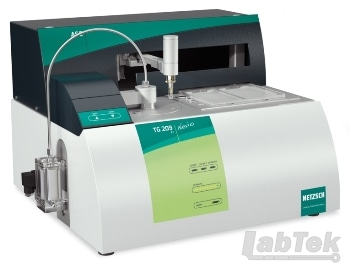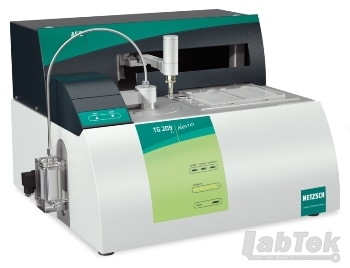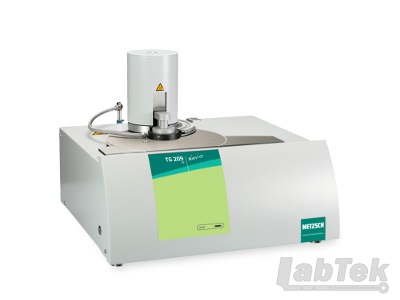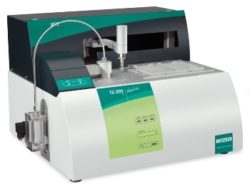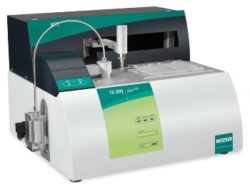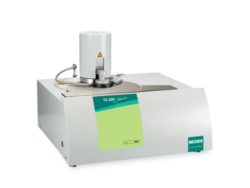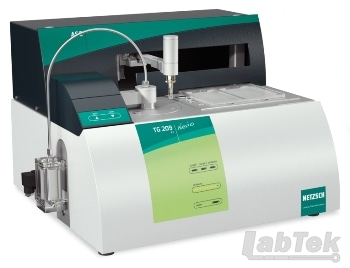- Mass changes
- Decomposition behavior
- Pyrolysis
- Water content
- Identification of solvents (even intercalated ones)
- Interactions with the surrounding gas atmosphere, e.g., oxidation
- Shelf life
- Thermal kinetics (in combination with Kinetics Neo)
- Identification of evolved gases (coupled to a gas analyzing system such as FT-IR, MS or GC-MS)
Features of the TG 209 F1 Nevio:
Innovative software solutions – AutoEvaluation and Identify
The unique AutoEvaluation software feature offers operator-free evaluation of thermogravimetric effects. Identify is a database-driven recognition system for the identification and classification of materials – all it takes is one click.
Direct detection of the sample temperature ‒ determination of endo- and exothermal effects
The sample thermocouple is in direct contact with the sample crucible and records all temperature changes inside the sample. Based on this, a c-DTA® signal can be calculated; this displays caloric effects and can be used for temperature calibration.
1100°C at the sample – the temperature displayed corresponds to the sample temperature
The sample-temperature-control mode allows for achieving the specified maximum temperature for the TG 209 F1 Nevio system of 1100°C at the sample.
Fast, corrosion-resistant ceramic micro furnace
The furnace is able to withstand even halogenated evaporation products. In addition, the low volume of the furnace in combination with the water-cooling provides a much faster cooling speed than air-cooled systems.
Robust top-loading balance arrangement
Easy accessibility to the sample and crucible as well as the ability to disconnect the sample carrier from the balance during loading or unloading of the sample are only two examples of how safe handling and maximum usability are ensured.
Ideally suited for being coupled to evolved gas analyzers
The vacuum-tight design of the instrument, which allows for the software-controlled evacuation and backfilling of inert gas (via the optional AutoVac), is the feature that provides uniform test conditions and ensures reproducible results. In addition, low gas flow rates result in high detection sensitivity as the evolved gases are only slightly diluted.
High sample throughput with the automatic sample changer
The automatic sample changer (ASC) is designed for measuring up to 192 samples (2 x 96) plus 12 extra positions for calibration materials or empty crucibles. The optional piercing device allows for the piercing of aluminum lids shortly before the sample pan is inserted into the furnace.
The Proteus® Protect software meets the requirements of 21 CFR Part 11.
?
Key Technical Data
(subject to change)
?
-
Temperature range (max.):
(10°C) … RT to 1100°C -
Max. cooling rate/ max. heating rate:
200 K/min -
Measuring range/ weighing range (max.):
2000 mg1) -
Enthalpy accuracy:
n/a -
TGA resolution:
0.1 μg -
Indium Response Ratio:
n/a -
Exchangeable sensors:
Yes -
Cooling options:
n/a -
Gas atmospheres:
Inert, oxidizing, static and dynamic -
Gas-tight/vacuum-tight:
Vacuum-tight -
Mass flow controller for purge/protective gas:
3, integrated (0 to 250 ml/min) -
Automatic Sample Changer (ASC):
Yes (optional) -
Software:
min. Proteus® 8 -
Advanced Software extensions (optional):
- Peak Separation
- Kinetics Neo
- Thermal Simulations
-
Size (W x H x D) – incl. ASC, without physical connections:
660 mm x 500 mm x 530 mm
1) minus weight of crucible
2) for indium
3) optimized temperature range for pharmacy, cosmetics and foodstuffs; depending on the selected furnaces: total temperature range: -150°C up to 2400°C
4) for thermocouple type E
5) using the equation published by B. Wunderlich, Thermal Analysis of Polymeric Materials, Springer (2005), page 346
6) in Al2O3 crucibles
?

